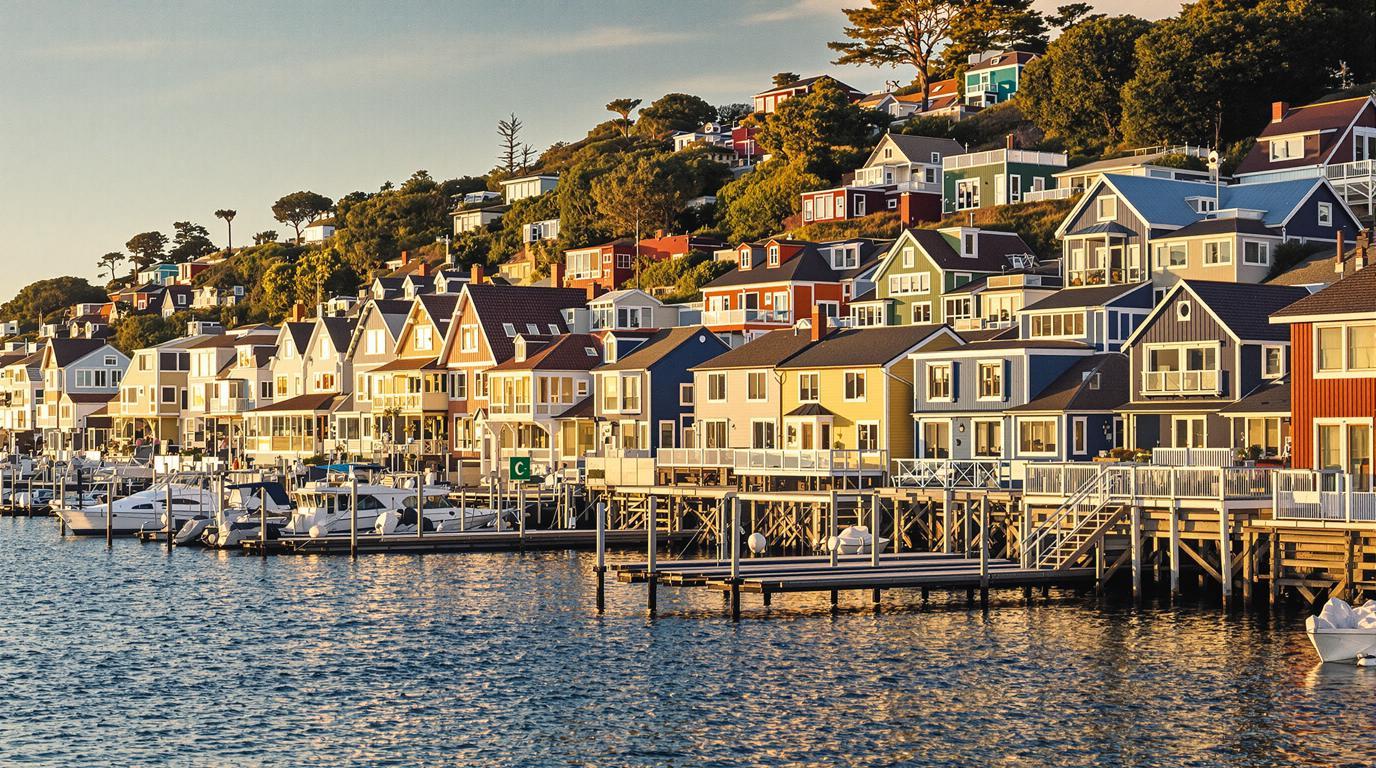I step off the ferry onto Sausalito’s wooden dock, squinting into the June sunlight reflecting off Richardson Bay. The waterfront panorama unfolds before me, revealing America’s densest floating village – 450+ houseboats clustered within this tiny 2.2-square-mile town of just 6,857 residents. That’s an astonishing 6.5% of Sausalito’s housing stock bobbing gently on the water’s surface. Despite being merely 7 miles from San Francisco’s crowded piers, this nautical neighborhood feels worlds apart from the tourist hordes across the bay.
“Most visitors come for the Golden Gate views and never discover our floating neighborhoods,” explains Celia Lyons-Labate, a longtime houseboat resident, as she welcomes me onto her vibrant blue two-story home at Waldo Point Harbor. “I felt I was home among the kerosene lamps and guitar strings the moment I arrived,” she says, gesturing toward the colorful collection of architectural anomalies surrounding us.
America’s Densest Floating Village: 450+ Houseboats in 2.2 Square Miles
The morning fog has burned off, unveiling a maritime community unlike anything else in America. Sausalito’s floating home density puts it in a category of its own – mathematically impressive with one houseboat for every 15 residents. Walking down the narrow wooden docks, I’m struck by the juxtaposition of architectural styles: repurposed World War II lifeboats next to sleek modern floating structures with rooftop solar arrays.
The scent of salt water mingles with fresh cedar as I hear jazz music drifting from an open window. A saxophonist practices on his deck, the notes carrying across the gentle ripples. Three otters playfully splash nearby, completely at home in this human-wildlife interface.
What makes this community truly remarkable is its origin story. After World War II, Marinship shipyard workers faced housing shortages and creatively repurposed military scrap materials. They built impromptu floating homes that evolved into this permanent architectural subculture – a quintessential example of California’s “make do with what you’ve got” spirit.
The temperature hovers at 72°F under cloudless skies – perfect conditions for exploring the five distinct floating neighborhoods stretched across 1.5 miles of protected waterfront.
Why Skip San Francisco’s Crowds for Sausalito’s Waterfront
The numbers tell a compelling story: while 1.2 million visitors descend on Sausalito annually (creating a staggering 17.5:1 visitor-to-resident ratio), the majority never venture beyond the main shopping street. Ferry passengers typically spend just 2.3 hours in town before returning to San Francisco’s Fisherman’s Wharf, where summer crowds can reach 45,000 daily visitors.
“Tourists come to take photos of houseboats from a distance, but rarely experience the community from within,” explains Marina Harbor Master James Pedroni. “The dock residents preserve this place as a living museum of maritime counterculture.”
Unlike San Francisco’s carefully curated attractions or Napa’s manicured vineyards, Sausalito’s floating villages offer something increasingly rare in Northern California: unpolished authenticity. Here, artistic expression trumps commercial potential. Where else can you find a full-size replica Viking ship docked beside a converted 1940s ferry boat transformed into a three-bedroom home?
Summer ferry crowds drop 40% compared to San Francisco piers, making June through September the sweet spot for unhurried exploration of this aquatic community. The summer fog patterns create a magical 2PM “Golden Hour” when sunlight bathes the colorful façades in warm golden tones – a photographer’s dream.
What the Guidebooks Won’t Tell You
For the optimal floating home experience, arrive via the 9:40AM ferry from San Francisco’s Ferry Building. This timing puts you in Sausalito before the midday rush but after residents have left for work, respecting their privacy. The $14 round-trip ticket includes spectacular bay views that wealthy tech executives pay millions for.
Liberty Dock offers the most photogenic collection of eccentrically designed houseboats, while Gate 5 Road provides access to the historic “anchor-outs” – boats moored offshore without land connections. For the perfect vantage point, rent a kayak from Sea Trek Kayak ($25/hour) and paddle through the floating neighborhoods from water level.
Bring $20 cash for the Floating Homes Association’s self-guided tour map, available at the Bay Model Visitor Center. This comprehensive guide includes historical details about specific houseboats that survived from the unregulated 1940s-60s era.
As I prepare to leave this floating enclave, the afternoon light casts long shadows across the wooden docks. A great blue heron stands sentinel at the end of the pier, as timeless as the maritime tradition it oversees. Sausalito’s floating homes represent something increasingly precious in the Bay Area – a community that values creative expression over convention, nautical heritage over tech-fueled modernization.
I can’t help but think how much my daughter Emma would love exploring these docks, counting the boat names and spotting marine life. In a region increasingly defined by Silicon Valley uniformity, Sausalito’s houseboats stand as wooden-hulled rebels – proof that sometimes the most extraordinary American communities are hiding in plain sight, just a ferry ride away from the crowds.
